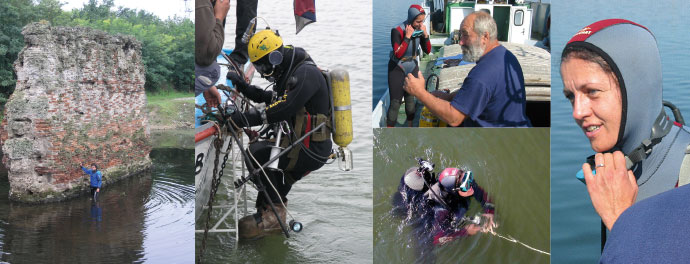Danube Watch 2/2018 - Rediscovering Trajan’s bridge over the Danube
Rediscovering Trajan’s bridge over the Danube
The Roman Emperor Trajan (53-117 AD) is remembered as a successful soldier-emperor who presided over the greatest military expansion in Roman history. Known for his philanthropic rule and his extensive public building programmes, he was also responsible for the construction of the first ever bridge to span the Lower Danube.

Gordana Karović, Director of the Underwater Archaeological Research of the Remains of the Trajan’s Bridge near Kostol-Turnu Severin project, taking part in the underwater research in 2003. Photo: Institute for the Protection of Cultural Monuments of Serbia.
The Trajan Bridge was built between the years 103 to 105 AD east of the Iron Gate Rapids at Turnu Severin to guarantee the supply line of Roman legions during the conquest of Dacia (modern-day Romania). The bridge consisted of timber arches mounted on masonry piers spanning the 800-metre-wide stretch of the river and had a total length of over 1000 metres. A century and a half later the emperor Aurelian withdrew from Dacia and demolished the bridge. Its 54-metre spans were the longest ever constructed at the time and would not be surpassed for more than a thousand years. Today the only visible remains of the bridge are the approach sections in the village of Kostol on the Serbian riverbank and in the city of Turnu Severin on the left Romanian riverbank.
Forgotten for centuries, the remains of the bridge reappeared in 1858 when the level of the Danube hit a record low due to an extensive drought. Initial archaeological research and excavation of the bridge was carried out during the 1980s as part of the Iron Gates Dam construction project. The underwater pillars on the bed of the Danube, their position and level of preservation were examined using a special vessel equipped with sonar. This was the first time that the length of the bridge, amounting to just under 1,070 metres, had been precisely measured.
In 2003, exactly 19 centuries after the beginning of its construction, the Serbian Ministry of Culture financed an underwater archaeological project to carry out comprehensive research on the remains of the bridge. Conducted by the Institute for the Protection of Cultural Monuments of Serbia, the purpose of the project was to provide answers to a number of questions, including what construction materials and techniques had been used to sink the pillars into the riverbed and what the exact dimensions, shape and height of the bridge were.
Hydrographic measurements using multibeam sonar were carried out in the zone of the remains across the whole section of the bridge, while other, non-destructive investigations, were conducted on the Serbian side of the river. Underwater digital photogrametric technology was used to obtain accurate three-dimensional geometry of all underwater archeological remains on the riverbed and to create a digital 3D model.
Unfortunately, financing of the project was discontinued before the 3D photo image of the scattered archeological elements on the riverbed could be completed. However, further research was conducted in 2014 using modern civil engineering analysis methods, coupled with a review of available materials and historical records of Roman construction techniques. This revealed that a variety of local trees, including the European oak which is still common to the area, could have provided beams both large enough and strong enough to fashion the bridge’s arches and deck. The Romans probably cut the wood and fashioned much of the structure before assembling the bridge, thereby using the same construction techniques that are used today: prefabrication and construction on site. Without a definitive historical record, there is no way to be sure exactly how the bridge looked, but sound engineering analyses has greatly narrowed the possibilities. Future research will hopefully provide even more details about the bridge, widely considered to be one of the wonders of the western world at the time of its construction.






